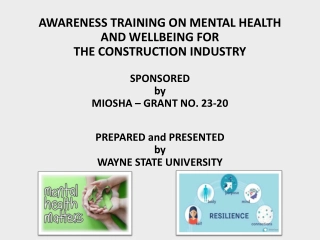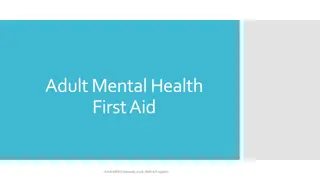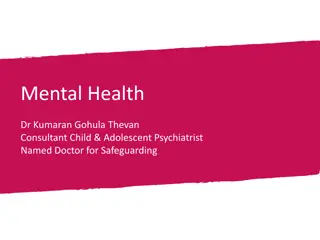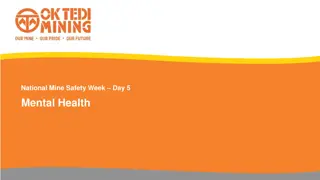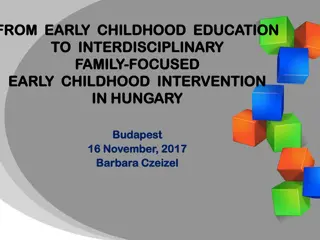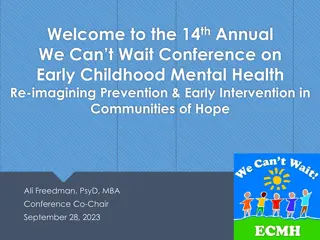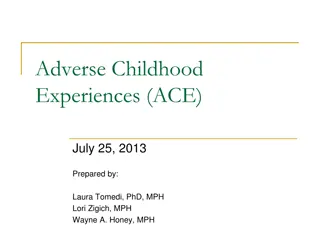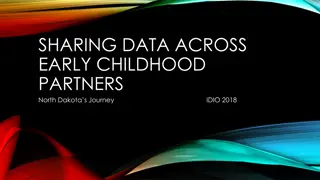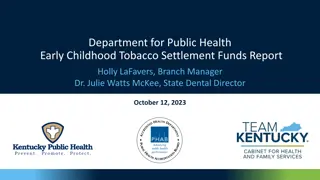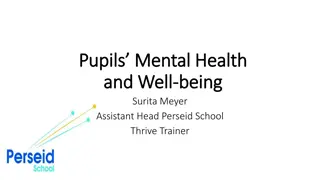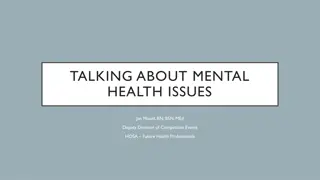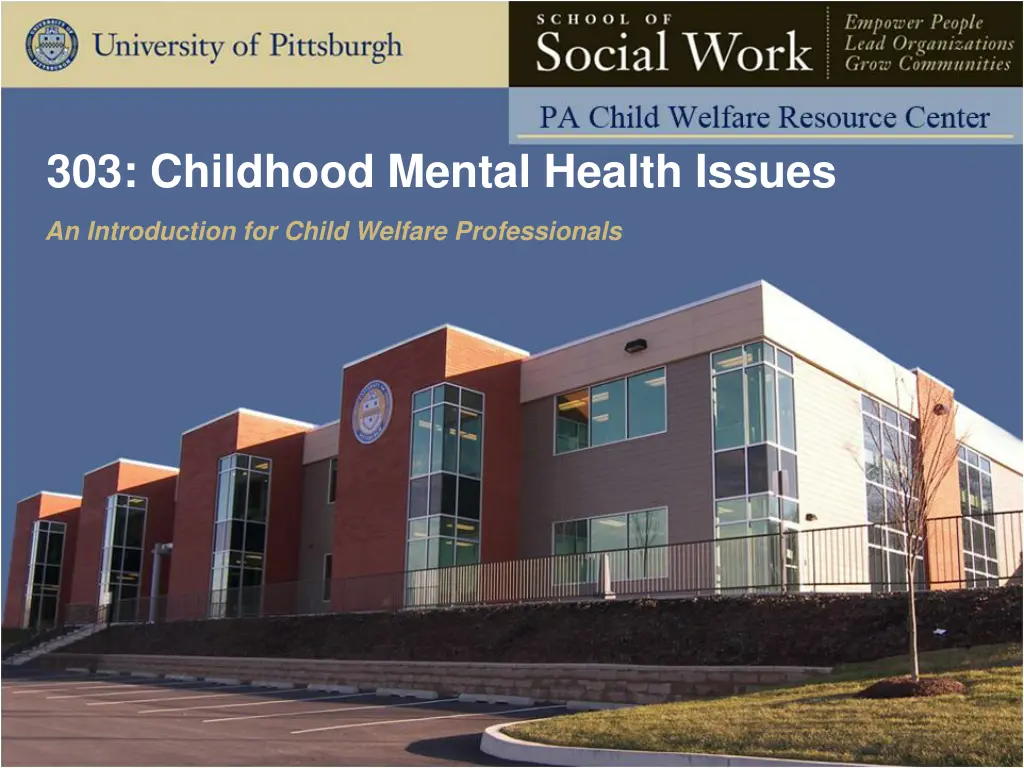
Understanding Childhood Mental Health Issues in Child Welfare
Explore the vital introduction to childhood mental health issues for child welfare professionals. Discover the importance, learning objectives, and key topics covered in this comprehensive program aimed at safeguarding children's well-being.
Download Presentation

Please find below an Image/Link to download the presentation.
The content on the website is provided AS IS for your information and personal use only. It may not be sold, licensed, or shared on other websites without obtaining consent from the author. If you encounter any issues during the download, it is possible that the publisher has removed the file from their server.
You are allowed to download the files provided on this website for personal or commercial use, subject to the condition that they are used lawfully. All files are the property of their respective owners.
The content on the website is provided AS IS for your information and personal use only. It may not be sold, licensed, or shared on other websites without obtaining consent from the author.
E N D
Presentation Transcript
303: Childhood Mental Health Issues An Introduction for Child Welfare Professionals
AGENDA Day 1 Introduction and Importance of Child/Adolescent Mental Health Issues in Child Welfare Perceptions about Child/Adolescent Mental Health Issues Child/Adolescent Development Child/Adolescent Mental Health Disorders 303: Childhood Mental Health Issues: An Introduction for Child Welfare Professionals The Pennsylvania Child Welfare Resource Center 2
AGENDA Day 2 Child/Adolescent Mental Health Disorders (continued) The Players in the Child/Adolescent Mental Health System Conclusions and Evaluations 303: Childhood Mental Health Issues: An Introduction for Child Welfare Professionals The Pennsylvania Child Welfare Resource Center 3
Learning Objectives Recognize safety threats and risk factors that might lead to or result in additional child abuse and neglect in children/adolescent with mental health issues Recognize how and when a caseworker needs to intervene to assure safety, permanency and well-being for children/adolescents with mental health issues Apply solution-focused questioning strategies with children and families coping with child/adolescent mental health issues 303: Childhood Mental Health Issues: An Introduction for Child Welfare Professionals The Pennsylvania Child Welfare Resource Center 4
Learning Objectives, continued Collaborate with the Mental Health system while still abiding by the laws and regulations associated with confidentiality and release of records Explain how effective outcome-based treatment is based on comprehensive, ongoing assessment of children/adolescent with mental health issues 303: Childhood Mental Health Issues: An Introduction for Child Welfare Professionals The Pennsylvania Child Welfare Resource Center 5
Child and Adolescent Mental Health in Child Welfare Practice One in five children in U.S. ages 3-17 experience a mental disorder in a given year An estimated $247 billion is spent each year on childhood mental disorders (Centers for Disease Control and Prevention, 2013) Among children between ages 9 and 17, 5 to 9% have emotional disturbances severe enough to impair their functioning (SAMSHA, 2013) 303: Childhood Mental Health Issues: An Introduction for Child Welfare Professionals The Pennsylvania Child Welfare Resource Center 6
Child and Adolescent Mental Health in Child Welfare Only 50.6% of children with mental disorders received treatment for their disorder within the past year Children with anxiety disorders were the least likely (32.2%) to have received treatment in the past year (U.S. Department of Health and Human Services, 2010) Lack of treatment for children/adolescents diagnosed with mental health disorders places them at higher risk for abuse and neglect (Administration for Children and Families, 2012) 303: Childhood Mental Health Issues: An Introduction for Child Welfare Professionals The Pennsylvania Child Welfare Resource Center 7
Biopsychosocial Factors Temperament Flexible, feisty temperament Negativity or positive affectivity Genetic Heritability Physiological Low birth weight Medical conditions Environmental Adverse childhood experiences Life stressors 303: Childhood Mental Health Issues: An Introduction for Child Welfare Professionals The Pennsylvania Child Welfare Resource Center 8
Perceptions and Attitudes About Mental Health Issues 3. Infants and toddlers can be 1. Mental health disorders diagnosed with mental are not true medical health disorders. illnesses like heart disease and diabetes. 4. Mental illness is not the result of bad parenting. 2. If a child has a parent who is mentally ill, the child will 5. Children with have mental health issues enuresis/encopresis have too. been abused or neglected. 303: Childhood Mental Health Issues: An Introduction for Child Welfare Professionals The Pennsylvania Child Welfare Resource Center 9
STIGMA Stigma is a severe social disapproval of personal characteristics or beliefs that are against cultural norms. 303: Childhood Mental Health Issues: An Introduction for Child Welfare Professionals The Pennsylvania Child Welfare Resource Center 10
Helping Families Understand Their Child/Adolescent s Development Share information on Identify mentors who can developmental expectations provide individualized that fit the philosophy, cultural education worldview and current patterns Arrange for parenting classes, within the family. parent support groups Encourage connections with Provide resource materials family members and friends Model appropriate interactions that have experience with child and expectations rearing. 303: Childhood Mental Health Issues: An Introduction for Child Welfare Professionals The Pennsylvania Child Welfare Resource Center 11
Solution-Focused Questions: Exception and Scaling Exception Questions Scaling Questions Elicit information about Invite clients to put their times when their problems observations, impressions, could have occurred but and predictions on a scale of 0 (no chance) to 10 (every didn t or were less severe chance) Focus on the who, what, when, and where NOT why Need to be specific (Shulman, 2006) 303: Childhood Mental Health Issues: An Introduction for Child Welfare Professionals The Pennsylvania Child Welfare Resource Center 12
Solution-Focused Questions: Miracle Questions Give permission to think about an unlimited range of possibilities for change Move the focus away from problems toward a more satisfying life (Shulman, 2006) 303: Childhood Mental Health Issues: An Introduction for Child Welfare Professionals The Pennsylvania Child Welfare Resource Center 13
Mental Health Service Use for Children 11.3% of U.S. children ages 2-7 (13.4% in PA) are reported by their parents to have been diagnosed with emotional, behavioral, or developmental conditions 24.8% have family incomes below the Federal poverty level (23.6% in PA) 29.4% had insurance, but it did not meet their mental health needs (U.S. Department of Health and Human Services, 2010) 303: Childhood Mental Health Issues: An Introduction for Child Welfare Professionals The Pennsylvania Child Welfare Resource Center 14
Mental Health Service Use for Children, continued ADHD was the most prevalent diagnosis among children ages 3-17 Boys were more likely than girls to have ADHD, behavioral or conduct problems, autism spectrum disorder, anxiety, and Tourette Syndrome Girls were more likely to be diagnosed with depression Suicide is the second leading cause of death among children ages 12-17 (Centers for Disease Control and Prevention, 2013) 303: Childhood Mental Health Issues: An Introduction for Child Welfare Professionals The Pennsylvania Child Welfare Resource Center 15
Categories of Disorders Depressive and Bipolar Disorders Major Depressive Disorder Persistent Depressive Disorder (Dysthymia) Bipolar Disorder Disruptive Mood Dysregulation Disorder Anxiety and Obsessive-Compulsive Disorders Separation Anxiety Disorder Generalized Anxiety Disorder Obsessive-Compulsive Disorder Trauma and Stressor-Related Disorders Reactive Attachment Disorder Disinhibited Social Engagement Disorder Posttraumatic Stress Disorder 303: Childhood Mental Health Issues: An Introduction for Child Welfare Professionals The Pennsylvania Child Welfare Resource Center 16
Categories of Disorders, continued Disruptive, Impulse Control, and Conduct Disorders Oppositional Defiant Disorder Intermittent Explosive Disorder Conduct Disorder Feeding and Eating Disorders Anorexia Nervosa Bulimia Nervosa Binge-Eating Disorder Neurodevelopmental Disorders Autism Spectrum Disorder Attention Deficit Hyperactivity Disorder 303: Childhood Mental Health Issues: An Introduction for Child Welfare Professionals The Pennsylvania Child Welfare Resource Center 17
Co-Morbidity and Co-Occurrence Statistics 40.3% of diagnosed children have more than one emotional, behavioral, or developmental condition 45.8% of children with one or more emotional, behavioral, or developmental conditions also had learning disabilities when compared to 2.7% of children without these conditions (U.S. Department of Health and Human Services, 2010) Estimated rates of co-occurring mental illness among adolescents with Substance-Related Disorders range from 60 to 75% (Substance Abuse and Mental Health Services Administration, 2010) 303: Childhood Mental Health Issues: An Introduction for Child Welfare Professionals The Pennsylvania Child Welfare Resource Center 18
Major Depressive Disorder Indicators (5 or more in same two-week period) Depressed mood Feelings of worthlessness or guilt Diminished interest or Diminished ability to think or pleasure in activities concentrate or Weight loss or weight gain indecisiveness Insomnia or hypersomnia Recurrent thoughts of death, Psychomotor agitation suicidal ideation, or suicide Fatigue or loss of energy attempt/plan (American Psychiatric Association, 2013) 303: Childhood Mental Health Issues: An Introduction for Child Welfare Professionals The Pennsylvania Child Welfare Resource Center 19
Depression and Suicide Statistics 13.84% of youth ages 12-17 report at least one major depressive episode in the last year Suicide is the second leading cause of death for youth between the ages of 10 and 24 Top three methods used in suicides of young people include firearm, suffocation, and poisoning Lesbian, gay, and bisexual youth in grades 7-12 attempt suicide at twice the rate of their heterosexual peers (Mental Health America, 2021; Centers for Disease Control and Prevention, 2013) 303: Childhood Mental Health Issues: An Introduction for Child Welfare Professionals The Pennsylvania Child Welfare Resource Center 20
Depression and Suicide Statistics, continued Native American/Alaskan Native youth have the highest rates of suicide-related fatalities Hispanic youth in grades 9-12 were more likely to report attempting suicide than their Black and white, non-Hispanic peers Documented rise depression, attempted suicides, and death by suicide during the Covid-19 pandemic, with disproportionate impact on ethnic minorities (NIMH, n.d.; Centers for Disease Control and Prevention, 2013; APA, 2021) 303: Childhood Mental Health Issues: An Introduction for Child Welfare Professionals The Pennsylvania Child Welfare Resource Center 21
Mania and Hypomania Episode Indicators Mania (at least 1 week) Hypomania (4 days) Distinct period of abnormally Distinct period of abnormally and persistently elevated, and persistently elevated, expansive, or irritable mood expansive, or irritable mood Abnormally and persistently Abnormally and persistently increased goal-directed activity increased goal-directed activity or energy or energy Significant impairment in Does not cause significant functioning functioning impairment 303: Childhood Mental Health Issues: An Introduction for Child Welfare Professionals The Pennsylvania Child Welfare Resource Center 22
Disruptive Mood Dysregulation Disorder Severe recurrent temper outbursts (verbal rages or physical aggression) Outbursts are inconsistent with developmental level Outbursts occur on average three or more times/week Mood between temper outbursts is persistently irritable or angry Symptoms must occur in two out of three settings Cannot be diagnosed for the first time before age 6 or after age 18 (American Psychiatric Association, 2013) 303: Childhood Mental Health Issues: An Introduction for Child Welfare Professionals The Pennsylvania Child Welfare Resource Center 23
Types of Anxiety Disorders Separation anxiety Selective mutism Specific phobia Social anxiety (social phobia) Panic disorder Agoraphobia Generalized anxiety (American Psychiatric Association, 2013) 303: Childhood Mental Health Issues: An Introduction for Child Welfare Professionals The Pennsylvania Child Welfare Resource Center 24
Anxiety Disorders: Common Threads Excessive fear (emotional response to real or perceived imminent threat) Anxiety (anticipation of future threat) Behavioral responses (fight, flight, freeze) (American Psychiatric Association, 2013) 303: Childhood Mental Health Issues: An Introduction for Child Welfare Professionals The Pennsylvania Child Welfare Resource Center 25
Prevalence Rates of Anxiety Disorders Lifetime prevalence of any anxiety disorder in U.S. children or adolescents (15-20%) Separation anxiety (2.8-8%) Selective mutism (0.03-1%) Specific and social phobias (10-7% respectively) Agoraphobia and panic disorder (1% in children) and (2-4% in adolescents) Generalized anxiety disorder (0.09% in adolescents) Girls are affected with anxiety disorders at twice the rate of boys (Beedso, Knappe, and Pine, 2011) 303: Childhood Mental Health Issues: An Introduction for Child Welfare Professionals The Pennsylvania Child Welfare Resource Center 26
Obsessive-Compulsive Disorder Indicators Presence of obsessions and/or compulsions Obsessions are recurrent and persistent thoughts, urges, or images that are experienced as intrusive and unwanted Compulsions are repetitive behaviors or mental acts that an individual feels driven to perform in response to an obsession or according to rules that must be applied rigidly (American Psychiatric Association, 2013) 303: Childhood Mental Health Issues: An Introduction for Child Welfare Professionals The Pennsylvania Child Welfare Resource Center 27
Reactive Attachment Disorder Indicators A consistent pattern of inhibited, emotionally withdrawn behavior toward adult caregivers, evident before age 5, and manifested by both of the following: Rarely or minimally seeks comfort when distressed Rarely or minimally responds to comfort offered when distressed A persistent social and emotional disturbance characterized by at least 2 of the following: Minimal social and emotional responsiveness to others Limited positive affect Episodes of unexplained irritability, sadness, or fearfulness which are evident during nonthreatening interactions with adult caregivers (American Psychiatric Association, 2013) 303: Childhood Mental Health Issues: An Introduction for Child Welfare Professionals The Pennsylvania Child Welfare Resource Center 28
Reactive Attachment Disorder Indicators, continued Child has experienced a pattern of extremes of insufficient care (pathogenic care) as evidenced by at least one of the following: Persistent disregard of the child s basic emotional needs for comfort, stimulation, and affection (i.e., neglect) Persistent disregard of the child s basic physical needs. Repeated changes of primary caregiver that prevent formation of stable attachments (e.g., frequent changes in foster care) Rearing in unusual settings such as institutions with high child/caregiver ratios that limit opportunities to form selective attachments Not due to Autism Spectrum Disorder (American Psychiatric Association, 2013) 303: Childhood Mental Health Issues: An Introduction for Child Welfare Professionals The Pennsylvania Child Welfare Resource Center 29
Disinhibited Social Engagement Disorder Due to a pattern of insufficient care (pathogenic care) Attachment may or may not be present A pattern of behavior in which the child actively approaches and interacts with unfamiliar adults by exhibiting at least 2 of the following: Reduced or absent reticence to approach and interact with unfamiliar adults Overly familiar behavior (verbal or physical violation of culturally sanctioned social boundaries) Diminished or absent checking back with adult caregiver after venturing away, even in unfamiliar settings Willingness to go off with an unfamiliar adult with minimal or no hesitation (American Psychiatric Association, 2013) 303: Childhood Mental Health Issues: An Introduction for Child Welfare Professionals The Pennsylvania Child Welfare Resource Center 30
Exposure to Trauma Children in the Child Welfare System often experience multiple traumas Serious neglect, abuse, exposure to domestic violence, and violence in communities 34% of youth in the Child Welfare System and 28% in the Juvenile Justice System experience four or more types of traumatic events (Substance Abuse Mental Health Services Administration, 2012) Most common trauma experienced by all children in the U.S. is interpersonal violence (National Child Traumatic Stress Network, 2013). 303: Childhood Mental Health Issues: An Introduction for Child Welfare Professionals The Pennsylvania Child Welfare Resource Center 31
Posttraumatic Stress Disorder Indicators Intrusion symptoms associated with the traumatic event(s) following exposure Avoidance of stimuli associated with the traumatic event(s) Changes in cognition and mood associated with the traumatic event(s) Significant changes in arousal and reactivity associated with the traumatic event(s) (American Psychiatric Association, 2013) 303: Childhood Mental Health Issues: An Introduction for Child Welfare Professionals The Pennsylvania Child Welfare Resource Center 32
Oppositional Defiant Disorder Indicators Angry/irritable mood Argumentative/defiant behavior Vindictiveness Rates range from 2 percent to 16 percent More prevalent in families where childcare is disrupted by a succession of different caregivers or in families in which harsh, inconsistent, or neglectful child-rearing practices are used (AACAP, 2019; American Psychiatric Association, 2013) 303: Childhood Mental Health Issues: An Introduction for Child Welfare Professionals The Pennsylvania Child Welfare Resource Center 33
Intermittent Explosive Disorder Recurrent behavioral outbursts representing a failure to control aggressive impulses manifested by either of the following: Verbal aggression or physical aggression that does not result in destruction of property or physical injury Three outbursts within a 12-month period involving destruction of property and/or physical injury to animals or people Outbursts are grossly out of proportion to the provocation or precipitating stressor and are not premeditated Must be at least 6 years of age or developmental level (American Psychiatric Association, 2013) 303: Childhood Mental Health Issues: An Introduction for Child Welfare Professionals The Pennsylvania Child Welfare Resource Center 34
Conduct Disorder Indicators Pattern of behavior in which the basic rights of others or societal norms and rules are violated Behaviors must fall into three out of four categories Aggression to people/animals Destruction of property Deceitfulness or theft Serious violation of rules (American Psychiatric Association, 2013) 303: Childhood Mental Health Issues: An Introduction for Child Welfare Professionals The Pennsylvania Child Welfare Resource Center 35
Conduct Disorder Indicators, continued Three subtypes Childhood onset (prior to age 10) Adolescent subtype (no symptoms prior to age 10) Unspecified (not enough information to determine onset) Specifier code added if symptoms reflect limited prosocial emotions Lack of remorse, empathy, concern about performance, or affect Higher risk for abuse (child with CD and others) (American Psychiatric Association, 2013) 303: Childhood Mental Health Issues: An Introduction for Child Welfare Professionals The Pennsylvania Child Welfare Resource Center 36
Feeding and Eating Disorders Statistics Common thread is a persistent disturbance of eating or eating-related behavior that significantly impairs physical health or psychosocial functioning Anorexia Nervosa (0.4%) Bulimia Nervosa (1-1.5%) Binge-Eating Disorder (1.6% in females and 0.8% in males) (American Psychiatric Association, 2013) 303: Childhood Mental Health Issues: An Introduction for Child Welfare Professionals The Pennsylvania Child Welfare Resource Center 37
Anorexia Nervosa Indicators Restriction of food intake leading to significantly low body weight Intense fear of gaining weight or becoming fat Disturbances in the self evaluation of body weight or shape (American Psychiatric Association, 2013) 303: Childhood Mental Health Issues: An Introduction for Child Welfare Professionals The Pennsylvania Child Welfare Resource Center 38
Bulimia Nervosa Indicators Recurrent episodes of binge eating Eating an amount of food within any 2-hour period that is significantly larger than what most individuals would eat and a sense of lack of control overeating during the episode Recurrent behaviors to prevent weight gain Self-induced vomiting, misuse of laxatives, misuse of diuretics, fasting or excessive exercise Self-evaluation disturbances Unduly influenced by body shape and weight Binging/purging both occur (once a week for 3 months) (American Psychiatric Association, 2013) 303: Childhood Mental Health Issues: An Introduction for Child Welfare Professionals The Pennsylvania Child Welfare Resource Center 39
Binge-Eating Disorder Indicators Eating an amount of food within any 2-hour period larger than what most people would eat and a sense of lack of control overeating during the episode Binge-eating episodes associated with eating rapidly, eating until uncomfortably full, eating large amounts of food when not feeling physically hungry, eating alone due to embarrassment over the amount of food eaten, or feeling depressed or guilty after the episode Episodes occur on average at least once a week for 3 months (American Psychiatric Association) 303: Childhood Mental Health Issues: An Introduction for Child Welfare Professionals The Pennsylvania Child Welfare Resource Center 40
Feeding and Eating Disorders Recommendations Model healthy Talk about unrealistic media thoughts/behaviors images Prohibit teasing about body Model how a competent person shape/size takes charge, solves problems, Emphasize fitness negotiates relationships, builds Praise children for who they a satisfying life are Get help when needed Encourage healthy eating (National Association of Anorexia Nervosa, 2013) Don t forbid certain foods 303: Childhood Mental Health Issues: An Introduction for Child Welfare Professionals The Pennsylvania Child Welfare Resource Center 41
Autism Spectrum Disorder Indicators Social communication and social interaction deficits Social-emotional reciprocity Nonverbal communication behaviors used for social interaction Developing, maintaining, and understanding relationships Restricted, repetitive behaviors, interests, or activities Stereotyped or repetitive movements, use of objects, or speech Insistence on sameness Fixated interests Hyper- or hypo-reactivity to sensory input (American Psychiatric Association, 2013) 303: Childhood Mental Health Issues: An Introduction for Child Welfare Professionals The Pennsylvania Child Welfare Resource Center 42
Attention Deficit Hyperactivity Disorder Primary feature is a persistent pattern of inattention and/or hyperactivity-impulsivity that interferes with functioning or development Present before age 12 and manifests in two or more settings Three subtypes within the disorder are less known: Predominantly Inattentive Predominantly Hyperactive/Impulsive Combined (American Psychiatric Association, 2013) 303: Childhood Mental Health Issues: An Introduction for Child Welfare Professionals The Pennsylvania Child Welfare Resource Center 43
Attention Deficit Hyperactivity Disorder Indicators Inattention (six or more) Fails to give close attention to details Difficulty maintaining attention Does not seem to listen when spoken to directly Does not follow through on instructions Difficulty organizing tasks or activities Often avoids tasks requiring sustained attention Loses things necessary for completing tasks or activities Easily distracted by extraneous stimuli Often forgetful in daily activities (American Psychiatric Association, 2013) 303: Childhood Mental Health Issues: An Introduction for Child Welfare Professionals The Pennsylvania Child Welfare Resource Center 44
Attention Deficit Hyperactivity Disorder Indicators, continued Hyperactivity and impulsivity (six or more) Often fidgets with or taps hands or feet Leaves seat in situations when being seated is expected Runs/climbs in situations where it is inappropriate Unable to play or engage in leisure activities quietly Is often on the go, acting as if driven by a motor Often talks excessively Blurts out answer before a question has been completed Difficulty waiting their turn Interrupts or intrudes on others (American Psychiatric Association, 2013) 303: Childhood Mental Health Issues: An Introduction for Child Welfare Professionals The Pennsylvania Child Welfare Resource Center 45
Mental Health Referral Checklist Identifying issues Coping mechanisms Family health issues Language and communication skills Information on the pregnancy, labor, and delivery Description of play Feeding/oral behaviors Mood Sleep patterns Fears and anxieties Activity and motor development Behaviors Social skills and social Relationships with others environment 303: Childhood Mental Health Issues: An Introduction for Child Welfare Professionals The Pennsylvania Child Welfare Resource Center 46
Managed Care in Pennsylvania (sample) Check with your supervisor for current information for your area. 303: Childhood Mental Health Issues: An Introduction for Child Welfare Professionals The Pennsylvania Child Welfare Resource Center 47
Characteristics of a Quality Evaluation Report Comprehensive Organized Respectful Individualized Thoughtful 303: Childhood Mental Health Issues: An Introduction for Child Welfare Professionals The Pennsylvania Child Welfare Resource Center 48
Treatment Approaches Psychotherapy Play therapy Behavior modification Grief therapy Cognitive behavioral Trauma-informed care therapy (CBT) Pharmacology Family therapy (psychotropic medication) 303: Childhood Mental Health Issues: An Introduction for Child Welfare Professionals The Pennsylvania Child Welfare Resource Center 49
Transfer of Learning What are two things you learned today that you might apply immediately to your casework? What are three concepts you plan to share with your supervisor? Which resources/handouts from your session today do you plan to share with co-workers? 303: Childhood Mental Health Issues: An Introduction for Child Welfare Professionals The Pennsylvania Child Welfare Resource Center 50

